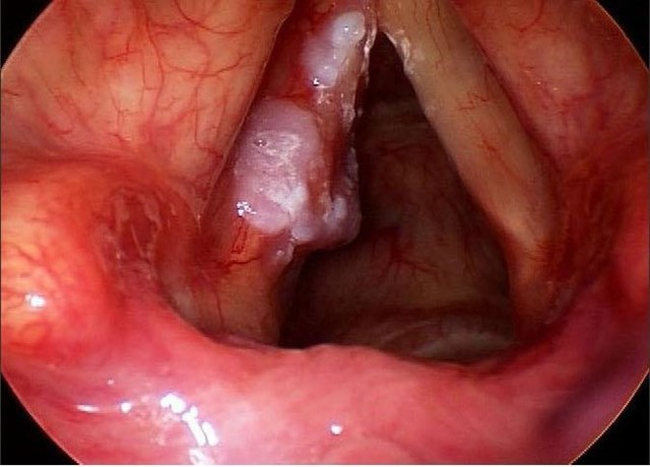Learn about subglottic nerve fibroma
Subglottic neurofibromatosis is an extremely rare disease. There have been a number of reported cases in our country. Manifestations of the disease are not specific, easily confused with other tumors around the neck.
1. What is a subglottic nerve fibroma?
According to NCBI, neurofibromatosis was first described in 1908 by Verocay. They are slow-growing, benign, submucosal tumors originating from the Schwann cells of the peripheral nervous system. Approximately 25% to 45% of all neurofibromatosis cases occur in the head and neck region, rarely in the larynx (80% in the epiglottis and 20% in the vocal cords), and they accounts for only 0.1% to 1.5% of all benign laryngeal tumors.
Subglottic nerve fibroma occurs at any age, and women are twice as likely to develop it as men. Most of these tumors arise from the inner branch of the laryngeal nerve.
2. Common clinical symptoms

Ung thư thanh quản có triệu chứng dễ nhầm với u sợi thần kinh hạ thanh môn
Symptoms of subglottic neurofibromatosis are often non-specific, the severity of the disease being mild or severe depending on the location and size of the tumor. Clinically, two main symptoms are common, hoarseness and shortness of breath, specifically:
2.1 Voice disorders Initially, the patient feels discomfort in the throat, sore throat, difficulty swallowing, voice disorder, hoarseness. sound, swelling, persistent, lasting for many years, medical treatment does not help.
The tumor grows slowly, the degree of hoarseness increases insignificantly over time, this is to distinguish it from the symptoms of laryngeal cancer.
2.2 Shortness of breath As the tumor increases in size, the diameter of the lower larynx narrows, obstructing air in and out, causing a variety of symptoms characteristic of laryngeal dyspnea. This is slow dyspnea, inspiratory time, with hissing sound, contractions of the accessory respiratory muscles in the supraclavicular, supraclavicular and intercostal muscles, which may also be accompanied by grimaces, open mouth, and head tilted back to breathe.
Patient feels more comfortable sitting up or lying with head elevated. There have been a few cases of persistent dyspnea progressing to chronic respiratory failure.
3. Diagnosis of glottis nerve fibroma

Chụp MRI giúp chẩn đoán phân biệt với u nang thanh quản, thanh quản
3.1 Anesthesia Laryngoscopy Laryngoscopy with anesthesia showed a large smooth, pink, non-ulcerative swelling, average size 2.5 cm, protruding into the lumen of the hypoglottic airways subject . When the tumor is large enough to cover almost the entire airway, the endoscope is difficult to get inside.
3.2 Computed tomography of the neck MRI is a better means of evaluating tumor organization and surrounding software than CT, but in addition to being cheaper, the assessment of invasion of surrounding cartilage and bone organizations is better than CT. did a lot better. On CT film, there is a round, heterogeneous mass, no image of lymph node metastasis and cartilage destruction.
On the MRI film, there is no abnormality in the T1 hyperenhanced lesion and the surrounding lymph node structure. Differential diagnosis with laryngeal cysts, larynx, adenomas, chondromas and malignancies.
3.3 Pathology Pathology is the gold standard for the diagnosis of subglottic neurofibromatosis.
Definitive diagnosis is based on the following 3 features:
Image of many nerve fiber cysts surrounded by a sheath, surrounded by connective tissue and blood vessels.

Hình ảnh Antoni A và B xen kẽ
Alternate Antoni regions A and B. The Antoni A region is made up of spindle cells with twisted nuclei, indistinct cytoplasmic borders, interspersed with microcapsules. In the Antoni B region, the cells are usually small, cortical, surrounded by basophilic mucus and spaced by blood vessels. Protein S-100 is an acidic protein found in the supporting cells of the central and peripheral nervous system and found in nerve fiber cells, particularly in the Antoni A region. This protein is believed to be the main criterion for the definitive diagnosis of subglottic neurofibromatosis.
4. Treatment of subglottic neurofibromatosis
Surgical excision is recommended because neurofibromas are less affected by radiation therapy and do not recur if completely resected. They are essentially submucosal tumors that are located outside the nerve cell and can therefore be easily detached.
Clinically, the choice of surgical modality depends on the location and size of the tumor. With small lesions can be resected endoscopically; however, larger lesions may require extrinsic access to the tumor in the form of medial and lateral thyroidectomy, oropharyngeal or laryngeal resection.
Subglottic neurofibromatosis is a rare disease in the world, it progresses very slowly over one to several years. Shortness of breath and voice disturbance are two common symptoms when the tumor is large and located near the vocal cords. Currently, surgical removal of the tumor is believed to be the most effective treatment. So, if you have the above symptoms, see your doctor to get the most accurate diagnosis.
Vinmec International General Hospital with a system of modern facilities, medical equipment and a team of experts and doctors with many years of experience in medical examination and treatment, patients can rest assured to visit. examination and treatment at the Hospital.
Để đặt lịch khám tại viện, Quý khách vui lòng bấm số HOTLINE hoặc đặt lịch trực tiếp TẠI ĐÂY. Tải và đặt lịch khám tự động trên ứng dụng MyVinmec để quản lý, theo dõi lịch và đặt hẹn mọi lúc mọi nơi ngay trên ứng dụng.
MORE
Laryngitis: Causes, symptoms, diagnosis and treatment How to care and treat acute laryngitis in children Causes and treatment of chronic laryngitis






